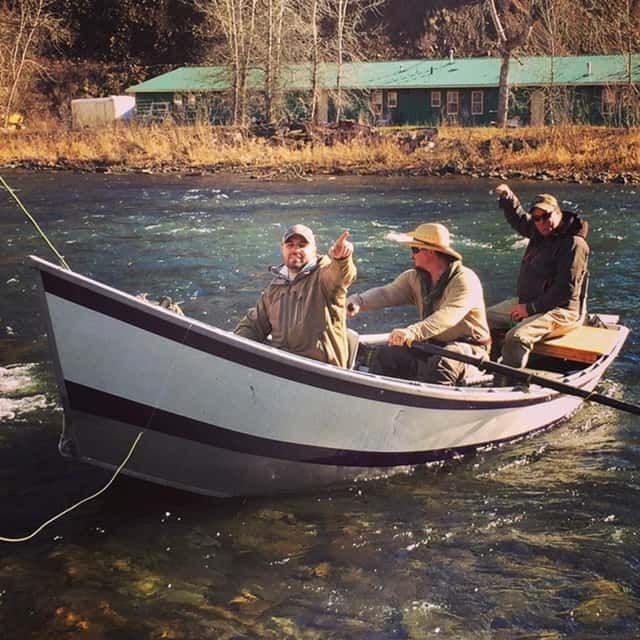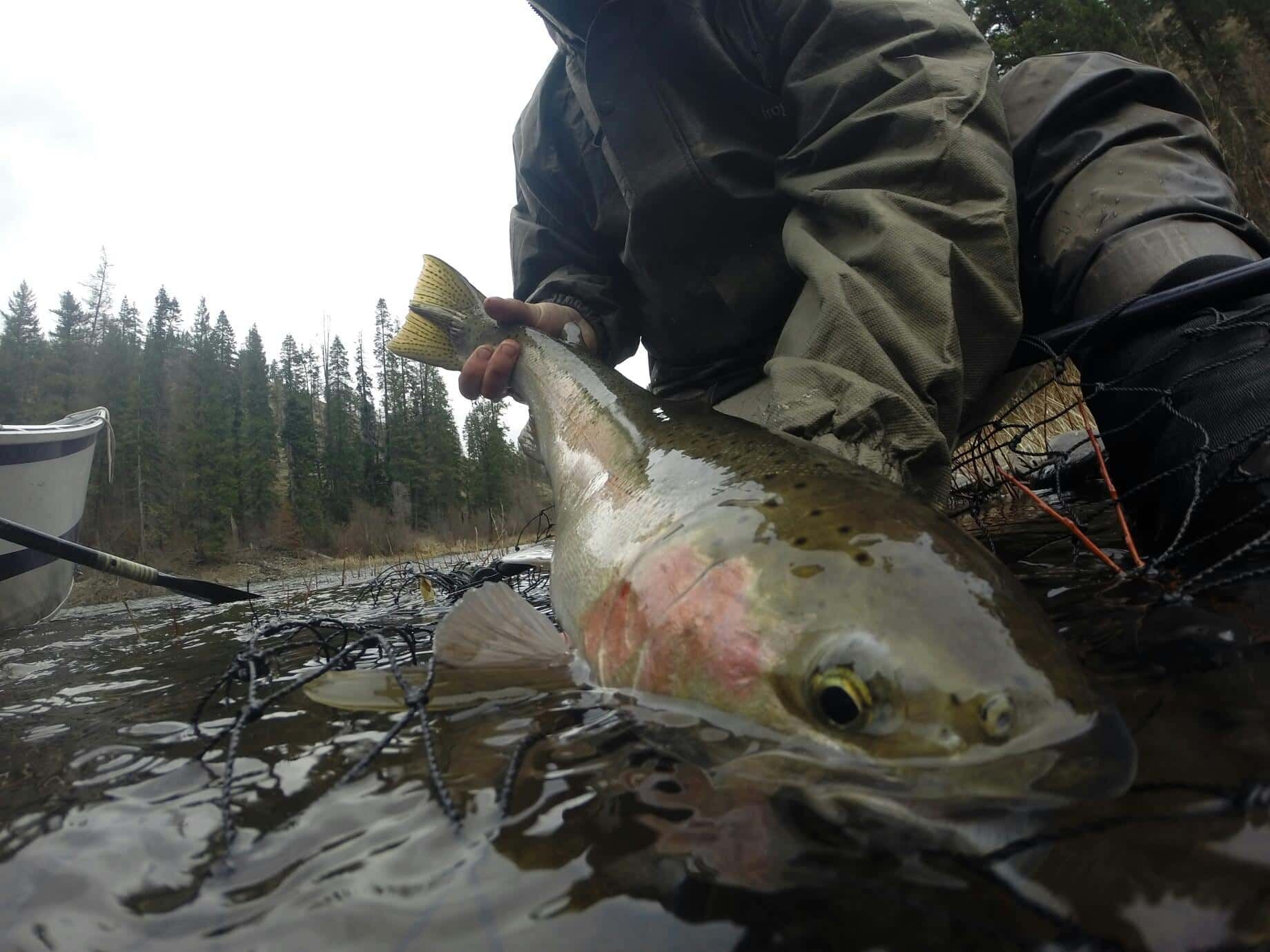Wild and Scenic Grande Ronde Steelhead Report
Key Takeaways
- Grande Ronde steelhead fishing peaks in early spring, when river flows stabilize and water color turns the ideal shade of “steelhead green,” offering the best opportunity for consistent catches.
- Variety in fly color matters less than presentation—successful anglers focused on dead-drift techniques in riffle tailouts and deep pools rather than specific hues.
- The Wild and Scenic stretch of the Grande Ronde offers unmatched serenity, where misty canyon mornings, wildlife sightings, and slow-paced Spey casting create an experience as memorable as the catch itself.
- Seasonal hatches like Blue Winged Olives, Caddis, and Skwala stoneflies enhance the river’s activity, making it an excellent time for both fishing and observing the ecosystem.
- A multi-day float trip from Minam to Wildcat Bridge delivers the full adventure, combining daily steelhead action with gourmet camp meals, scenic solitude, and a deep sense of connection to the river’s timeless rhythm.
Launching from Minam for 4 day Grande Ronde River Float on a Grande Ronde River float trip that showcases one of Oregon’s most scenic stretches of water
Fishing update for the Wild and Scenic
By James Nash
The Wallowa and Grande Ronde rivers have steelhead in them and earlier this week, the conditions for catching them reached what will likely be the most optimum levels for the Spring season. Winding Water River Expeditions floated from Minam to Wildcat Bridge with two anglers who work for the Rolls Royce of the fly rod industry, R. L. Winston Rod Co. My experience guiding anglers (on our guided white water rafting adventures through Eastern Oregon’s river canyons), by nature, usually involves instructing people who are on the youthful end of the experience spectrum. On this trip I found myself faced with the less common challenge of guiding men who were better fishermen than me. And so it was a perfect storm. The rivers had stabilized their flows and colored slightly due to last week’s drizzle, the steelhead were there in force, the weather was warm and overcast, we had the finest fly rods made in the United States and two anglers who, having had a hand in building them, knew how they should be used.
On the Wallowa River we caught fish on black, chartreuse, yellow, brown, orange, pink, peacock, and white colors; which reinforces the theory that fish do care about color but it is the aspect they care about the least. We hooked fish in the tailouts of long riffles and in deeper pools, as you might expect, and almost exclusively on a dead-drift presentation. The hatchery steelhead dogged somewhat and who could blame them after all they’d been through. Although these fish are close to their terminus, they do not give up easily as we experienced in spades later on when Jock hooked and landed a shining wild hen his 9’ #6 BIIX. After we released the fish with a trembling voice jock whispered “that’s what I came here for…” Then he looked at his rod with amazement and gratitude and back to the water from which his fish had come. He had just experienced something he’d thought about for decades and it was better than he’d imagined.
At night, full to bursting on gourmet three-course meals cooked by WWRE guide Morgan Jenkins, we saw large stoneflies attracted to the flames of our campfire. Trips like our Grande Ronde 5-day rafting adventure often highlight similar spring hatches and calm stretches ideal for fishing. During the day Blue Winged Olives, Caddis and Skwala stoneflies came off sporadically on both rivers. The Wallowa was easier floating than it had been earlier in the week, although the rock garden below Blind Falls was a predictably sweaty trial.
On our last night we listened to rain flowing in little creeks off the roof of our wall tent, kept cozy by a wood stove. Enough water accumulated in my drift boat to require 20 minutes of bailing with a Folger’s can in the morning. The Grande Ronde came up 1,000 CFS to just over 3,000 and the water turned to the brown side of steelhead green. That morning mist clung to the rims where four bighorn sheep watched us eat breakfast and pack camp. The mountain goats we’d seen the day before were concealed in clouds.
Wild Grande Ronde River Steelhead
After a Spring rain the canyon looks at the same time as if it were both very old and also brand new. The first arrow leaf balsam roots begin opening showing spots of yellow along the hillsides where soon bears will be out eating them. The old gray moss hangs off the fir trees dripping the night’s rain and the morning’s dew. The river itself, milder on the surface than before the rain slaps gently on the hull of the boat and beneath steelhead move from one place to the next towards the gravelly redd where they were born. If you didn’t know better you might think you were the first person to ever float through those canyons.
Stopping at pools and riffles, Adam and Jock stand on the edge of the water carving curves in the air with the long slow strokes of their Spey rods and then standing still as the line unrolls across the water, straightens, pauses briefly then falls into the current and begins swinging downstream then across and then straightening below them before the cycle begins anew. It isn’t every day we get a chance to be quiet and graceful, but this time of year on the Grande Ronde you can hardly avoid it. The pace and the experience are of the type that you start missing before you’ve even left, and you plan on returning. In addition to all of that, we caught Grande Ronde steelhead every day, hooked more than we landed, and left the river as we found it. For small groups or custom fishing itineraries, our private charter river trips offer the same quiet canyon experience tailored to your crew.
Frequently Asked Questions
Here are answers to common questions about steelhead fishing on Oregon’s Wild and Scenic Grande Ronde and Wallowa Rivers.
When is the best time to fish for steelhead on the Grande Ronde River?
The best time to fish for steelhead on the Grande Ronde is in early spring when river conditions stabilize after winter runoff. Around mid-March, flows often clear and water temperatures rise slightly—creating prime conditions for both hatchery and wild steelhead activity.
What types of flies work best for Grande Ronde steelhead?
Anglers have success using a variety of colors—black, chartreuse, pink, orange, yellow, brown, peacock, and white. While color plays a role, presentation and technique are more important. Dead-drift presentations in riffle tailouts and deep pools tend to produce the most consistent strikes.
How are river conditions during the spring steelhead season?
Spring conditions can fluctuate quickly. After light rain, flows may rise and turn slightly off-color, which often triggers strong steelhead movement. Ideal conditions include mild weather, stable flows around 3,000 CFS, and water clarity that’s “steelhead green.”
What kind of fishing techniques are most effective on the Grande Ronde?
Dead-drift nymphing and swinging flies with Spey rods are both effective methods. Steelhead are often found in riffle tailouts and deep pools. A smooth, patient presentation is key, as fish respond best to natural, subtle movement through the current.
Are both wild and hatchery steelhead found in the Grande Ronde?
Yes, both wild and hatchery steelhead return to the Grande Ronde each year. Hatchery fish tend to be more subdued fighters, while wild fish are strong and vibrant. Anglers are encouraged to release wild steelhead carefully to protect the river’s native population.
What kind of wildlife can you expect to see while floating the river?
The canyon is home to a range of wildlife including bighorn sheep, mountain goats, bears, and numerous bird species. Spring brings new life to the river corridor, with arrowleaf balsamroot blooming and stoneflies hatching along the banks.
What is the float like from Minam to Wildcat Bridge?
The float from Minam to Wildcat Bridge is scenic and moderately challenging, with stretches of calm water and a few technical sections like the rock garden below Blind Falls. It’s ideal for multi-day trips, offering excellent fishing and beautiful riverside campsites.
What are the main insect hatches in spring on the Grande Ronde and Wallowa Rivers?
Spring hatches include Blue Winged Olives, Caddis, and Skwala stoneflies. These insects provide steady surface activity throughout the day, especially during warm, overcast weather—conditions steelhead anglers dream of.
What makes the Grande Ronde River “Wild and Scenic”?
The Grande Ronde’s designation as a Wild and Scenic River protects its natural beauty, free-flowing waters, and diverse wildlife habitat. It ensures that future generations can experience the same pristine fishing, camping, and solitude that make the river so special.
Why do anglers return year after year to the Grande Ronde?
Beyond the excellent fishing, the Grande Ronde offers peace, solitude, and a deep connection with nature. Its timeless canyon scenery and graceful pace make it an experience that anglers start missing before they’ve even left the river.
The post Wild and Scenic Grande Ronde Steelhead Report appeared first on Winding Waters River Expeditions.







